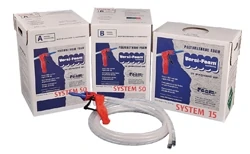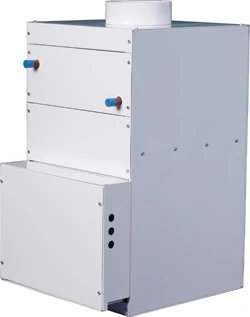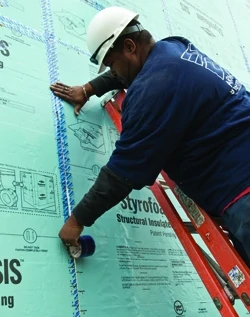SPF is quickly gaining ground as a high-demand insulating material. Here’s Why.
By Matt Weber
An increasingly popular method of home insulation is Spray Polyurethane Foam, commonly called Spray Foam or SPF.
Although pioneering work on polyurethanes was conducted as far back as 1937 in Germany, it was not until the early 1970’s that 2-pound/cu. ft. closed-cell foams were used in the U.S. for perimeter wall insulation. In the mid 1990’s, 1/2-pound/cu. ft. open-cell foams were brought into the market for interior wall insulation as seen in many of today’s new homes.
Spray Foam is a spray-applied insulating foam plastic that is installed as a liquid and then expands many times its original size. As home insulation, the concept is similar to living inside a sealed Styro Foam cooler. The foam can be adjusted to have many different physical properties depending on its intended use. For example, the same basic raw materials that can make insulation foam semi-rigid and soft to the touch also creates high-density roofing foam that withstands foot traffic and water. Specialized equipment is used to apply the Spray Foam, and proper training is important in order to get the best results.

As an insulating material SPF can provide high levels of R-value, while providing air barriers and moisture control in buildings. For roofing, spray polyurethane foam insulates and eliminates thermal bridging through fasteners or gaps in decking.
Spray foam is available in two versions; low-density/open-cell SPF and medium-density/closed-cell SPF. The low-density/open-cell SPF refers to a generic Spray foam that weighs between 0.4 to 0.6 lbs. per cubic foot when fully cured. It is spray-applied as a liquid and expands about 100-150 times its original volume to form a semi-rigid/flexible, non-structural SPF insulation. The low-density SPF has an R-value around 3.5 per inch.
Medium-density/closed-cell SPF used in interior applications refers to spray foam that weighs between 1.5 to 2 lbs. per cu. ft. when fully cured. It is also sprayed as a liquid onto a substrate and expands about 35 to 50 times its original volume to form a rigid, structural SPF insulation with a compressive strength between 15 to 25 PSI. The SPF has an aged R-value of around 6.0 per inch.

Benefits of SPF
Spray foam offers a number of benefits for residential construction. SPF is durable, maintains its physical properties over time (won’t sag), and for the “green” thinking consumer it contributes little to the waste stream. Plus, depending on the formula and project, a single product can take the place of three or four other products, including insulation, air barriers, sealants, vapor retarders and weather barriers.
“While there is a higher upfront cost for the installation of the foam, SPF can really cut down on energy bills in the long run,” says Ron Brown of Thermetix, a professional installer of SPF systems throughout Alabama. Although the initial cost of installation could be 3 to 4 times the cost of installing standard fiberglass batts, in as few as five years the homeowner can recoup their investment and enjoy lowered utility bills throughout the life of the house. SPF also has no food value to attract insects or rodents.
“Spray foam is also helpful for people who suffer from allergies,” says Brown, explaining that the seamless, continuous layer of insulation provides superb air quality and reduces pathogen growth.
Furthermore, according to the Spray Polyurethane Foam Alliance (www.sprayfoam.org), closed-cell SPF adds structural strength by “gluing” a building together, thereby making it more resistant to racking events, such as hurricanes and high winds. SPF also reduces noise from outside by air-sealing the building.
DIY or Hire a Contractor?
The specialized equipment to apply SPF is a complicated system that is generally transported by truck or trailer. The equipment requires special training, is very expensive and is typically owned or leased by the contractor (and unavailable for consumer rental). A whole-house application is a contractor job that is typically performed during new home construction.


However, for room additions and small-scale renovations, a serious do-it-yourselfer should explore the products offered by companies such as RHH Foam Systems or TigerFoam, which offer DIY kits that are both portable and disposable. For instance, the Versi-Foam kits from RHH are available in a variety of sizes and types, including open-cell, closed-cell, high-density and slow-rise foam insulation for a wide range of applications. You can find options for do-it-yourself SPF kits at www.rhhfoamsystems.com and www.tigerfoam.com.

For more information on spray polyurethane foam insulation, including the latest technological developments, visit the SFPA at www.sprayfoam.org.
Touch ‘n Foam Sealants
For “spot” home insulation applications, Touch ‘n Foam insulating sealants help control airflow in and out of homes by filling empty spaces in the home’s exterior or “shell”. Air-sealing the home means you’re better able to maintain a consistent temperature year-round while enjoying lower utility bills. Ready to use in handheld spray cans, the foam products expand to fill gaps and cracks, creating an effective barrier against the loss of heated (or cooled) air. Touch ‘n Foam sealants are also great for blocking moisture, dust, sound and insects, and a variety of product options help ensure you choose the right type for the job. Learn more at www.touch-n-foam.com.
Ingram’s Solar T-Kits
Supplement your home’s energy supply with power from the sun. Choose an Ingram’s T-Kit to make sure your home solar system is as easy, simple and reliable as possible. Each pre-configured kit is optimized and designed using the highest quality components, such as premium Talesun modules and high-efficiency Kaco Blue Planet inverters. The T-Kits are available in a multitude of system sizes to fit your energy needs. Plus, free monitoring is included for systems over 1kW to save you both time and money. Learn more at www.ingramswaterandair.com.
EnergySavr Window Inserts
EnergySavr Window Inserts are an effective, affordable interior insulation product for existing single- and double-pane windows. Window Inserts reduce outside air infiltration and create an insulating air space that cuts heating and cooling costs.
The inserts greatly increase occupant comfort, and even allow for greater flexibility in furniture placement due to the reduction of room draft and cold spots. Using a strong frame and a clear, high-strength film glazing, the EnergySavr inserts are lightweight, durable, will not shatter, and require minimal maintenance. They’re also quick and easy to measure, order and install. The inserts slide easily into the interior window sill, frame or trim opening of your existing windows. They install firmly in place by a compression fit for a clean, non-intrusive appearance. No extra hardware or tools are needed. Learn more at www.WindowInserts.com.
Big Stretch Sealant
When it comes to workability and stretch ability, it’s hard to top the Big Stretch caulk from Sashco.
It spreads as easily as mayonnaise and is ideal for filling large gaps where acrylic latex would normally shrink and pull away from the joint. In fact, Big Stretch can span gaps as wide as 2 inches (with a backer rod), and its superior adhesion and flexibility means it will stay in place. Instead of cracking, it compresses and stretches, capable of expanding more than twice its original size. Big Stretch is 100-percent acrylic latex, high-performance caulk that will absorb just about any movement a home can dish out, stretching up to five times the original joint size without cracking. Big Stretch is paintable and stainable, perfect for many interior and exterior applications, including: windows, doors, siding, vents, soffits, eaves and trim. Learn more at www.sashco.com.
Hi-Velocity SDHV System
The Hi-Velocity SDHV (Small Duct High Velocity) System is an energy-efficient, high-pressure air delivery system that can be designed to provide home and office with heating, cooling, filtration, ventilation, humidification and dehumidification. With the use of a high-pressure area to low-pressure area, room air is mixed continuously, creating even temperatures from floor to ceiling. Because the plenum duct is pressurized, dust buildup within the duct work is eliminated. Small diameter flexible duct makes it very easy to install inside existing walls with minimal remodeling. The duct fits inside a typical framed wall without having to disturb the drywall. Modular fan coils fit easily in mechanical rooms, closets, attics, crawlspaces, anywhere, and the small footprint makes it the right choice for both new construction and retrofits. The Hi-Velocity System can remove up to 30 percent more moisture from the air than conventional systems, leaving a constant and comfortable temperature on the skin surface, while saving money on monthly operating costs. Coming in 2013: the HE-Z Series with zoning capable right out of the box. Learn more at www.hi-velocity.com.
StyroFoam SIS Structurally Insulated Siding
StyroFoam SIS Brand Structural Insulated Sheathing combines structural lateral bracing and transverse wind-load resistance, insulation, water-resistive barrier and air-barrier properties in one solution. The sheathing can be used as braced wall panels integrated with other rigid insulated sheathing. It can also serve as continuous structural insulated sheathing over the entire wall line. The SIS sheathing provides high R-value (R-3 at 0.5-in.; R-5.5 at 1-in.) and eliminates the need for wood structural panels (e.g., OSB) and housewrap, wood let-in bracing or metal T-bracing. In addition, SIS helps lower the installed cost because it allows the builder to install structural support, insulation and a water-resistive barrier with one product and one less trip around the house.

The new Rheem Prestige Series Hybrid Heat-Pump Water Heater has the highest efficiency in its class (2.45 EF). This unit costs about $16 a month to operate and it can save a homeowner $329 annually (compared to a standard 50-gallon electric water heater). Instead of heating stored water directly with a conventional electric element, this water heater extracts available heat from the air, intensifies the heat and transfers the heat into the water. It also features a full-color, backlit, touch-screen—the only one of its kind found on any water heater. With the touch-screen, users can select from five operating modes based on their needs. The factory-installed setting is Energy Saver Mode, which predominantly uses the unit’s heat-pump functionality, but—when necessary—it will employ electric heat to get the water to the desired temperature. Other modes include Heat-Pump Only, High Demand, Electric Only and Vacation. Learn more at www.rheem.com.
Versi-Block
Versi-Block is a one-component polyurethane foam sealant that inhibits the passage of smoke through residential utility penetrations. It is bright orange in color to allow inspectors easy identification of an approved fireblock. Versi-Block has excellent adhesion to most building surfaces including wood, glass, metal, masonry and plastic. This innovative low-pressure/low-expansion formula creates a durable, airtight and waterproof seal that stops air infiltration and provides high insulation value. It is typically used to fill holes in the walls where pipes go through and in chimneys to seal around wood. Versi-Block has been tested according to ASTM E814 (modified), NFPA 268, and meets the requirements for fire blocking penetrations around wires, pipes, ducts, and other penetrating items in single-family residential construction. Learn more at www.rhhfoamsystems.com.
The Many Uses for Spray Foam—From Our Homes to Our Troops
Tiger Foam SPF has a wide array of uses, even for the U.S. military overseas.
“The product is very versatile,” says Jamie Rawlinson, technical director at Tiger Foam, which has one of the highest R-values in the SPF industry with a rating of R-7 per inch. “It’s ideal for use as residential or commercial insulation, but a lot of people have used it for boats, wine cellars, and coolers for food storage as well.”
The Tiger Foam product is supplied in two versions: a fast rise fire-rated formulation for new construction, and a slow rise formulation for retrofitting interior space. Plus, it is sometimes used as a component in multi-product insulating systems. “You can actually use foam in conjunction with other insulation materials,” says Rawlinson. “Our product has an air sealant factor, so people might use it for that purpose and then add rock wool or fiberglass or whatever else they might want. So if you have areas that might only get an R-11 with fiberglass, using it together with Tiger Foam takes them to an R-18.” Tiger Foam can also be used for insulating exposed pipes; for roofing systems and crawlspaces; to fill interior voids on concrete; and for use as an asbestos encapsulant.
Tiger Foam has even supported our troops overseas. “We shipped a ton of product over to Afghanistan and Iraq for insulating tents so they could run air conditioning to the tent to help the soldiers cool down,” explains Rawlinson. “One of the most important things for a lot of end users is the fact that this is a very portable product. It can be used just about anywhere, where the big professional rigs cannot.”
For more information, call 800-664-0063 or visit www.tigerfoam.com.












